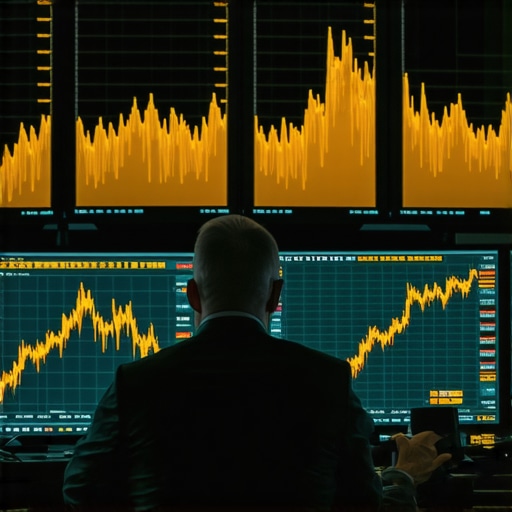Unveiling the Future of Gold Trading: A Strategic Perspective for 2025
As financial markets evolve amid geopolitical shifts and economic uncertainties, gold remains a cornerstone of diversified investment portfolios. For seasoned traders and institutional investors, understanding the nuances of gold trading in 2025 requires a deep dive into supply-demand dynamics, macroeconomic indicators, and technological innovations shaping the market. This article synthesizes expert insights and advanced strategies to optimize your gold trading endeavors this year.
Decoding Gold Price Drivers: Macroeconomic and Geopolitical Influences
In 2025, gold prices are intricately linked to macroeconomic factors such as inflation rates and real interest rates. As noted in recent market analyses, geopolitical tensions and central bank policies significantly influence gold’s safe-haven appeal. Traders who monitor these indicators can anticipate price swings and position themselves advantageously.
The Role of Supply-Demand Forces: Mining Trends and Consumer Industry Impact
Understanding the supply chain is crucial for strategic trading. As explored in industry reports, mining output, geopolitical stability in key producing countries, and evolving consumer demand, particularly in jewelry and technology sectors, shape market trajectories. Advanced traders leverage this knowledge to time entries and exits effectively.
Leveraging Technical Analysis and Market Sentiment
While fundamental factors set the stage, technical analysis provides tactical insights. Sophisticated tools, including Fibonacci retracements, moving averages, and volume analysis, help identify optimal entry points. Moreover, sentiment analysis, employing AI-driven data, reveals market positioning and potential reversals, aligning with expert recommendations for 2025 trading strategies.
How Can Advanced Traders Use Gold Futures and ETFs to Maximize Profits?
Futures contracts and exchange-traded funds (ETFs) are vital instruments for hedging and speculation. As detailed in specialist guides, deploying leverage cautiously and aligning positions with macroeconomic forecasts can amplify gains while managing risk.
What Are the Key Risks and Open Questions for Gold Traders in 2025?
Despite promising opportunities, traders face risks such as sudden geopolitical escalations, changes in monetary policy, and technological disruptions in gold extraction. Open debates persist about the sustainability of gold’s safe-haven status amid increasing digital asset competition. Staying informed through industry reports and expert opinion remains essential.
For investors eager to deepen their knowledge, exploring proven techniques for maximizing gold profits is highly recommended. Engaging with professional communities and sharing insights can also enhance your strategic approach in this dynamic market.
Sources such as the International Monetary Fund provide valuable data on global monetary policies influencing gold prices, reinforcing the importance of an analytical, research-driven approach to trading in 2025.
Unlocking New Dimensions in Gold Trading: A Deep Dive into 2025 Strategies
As we navigate the intricate landscape of global finance in 2025, seasoned traders recognize that success hinges on integrating advanced analytical tools and understanding evolving market fundamentals. Beyond traditional approaches, leveraging innovative data sources and sophisticated models can provide a competitive edge. This article explores cutting-edge strategies and challenges common assumptions, equipping traders with a nuanced perspective for optimizing gold investments this year.
What Role Will Artificial Intelligence Play in Shaping Gold Market Predictions?
AI-driven analytics are transforming how investors interpret market signals. Machine learning models analyze vast datasets—ranging from geopolitical news to macroeconomic indicators—to forecast short-term price movements with heightened accuracy. According to a recent industry report, integrating AI tools enables traders to identify subtle patterns that human analysis might overlook, thereby refining entry and exit timing.
Can traditional valuation metrics withstand the complexities of modern gold trading?
While fundamental indicators such as gold’s intrinsic value, supply chain robustness, and demand trends remain important, their predictive power may be challenged by rapid technological and geopolitical shifts. Experts argue that hybrid models combining classical valuation with real-time data analytics offer a more resilient framework. For instance, monitoring central bank reserve changes, as discussed in industry insights, complements quantitative models and enhances decision-making accuracy.
How Can Traders Anticipate and Adapt to Sustainable Market Disruptions?
Market disruptions—be they geopolitical conflicts, technological breakthroughs in gold extraction, or shifts in consumer demand—require agility. Developing scenario analysis frameworks allows traders to simulate various outcomes and prepare contingency plans. Additionally, staying informed through authoritative sources like the expert forecasts helps anticipate potential shocks. Embracing diversification—such as incorporating gold ETFs or mining stocks—can mitigate risks associated with sudden market swings.
What Are the Practical Steps to Integrate These Advanced Strategies into Your Portfolio?
Implementing these insights involves a combination of technological adoption and strategic planning. Start by upgrading your analytical toolkit with AI-powered platforms and real-time data feeds. Next, revisit your risk management protocols to incorporate scenario planning and dynamic hedging techniques. For detailed guidance, exploring resources like proven techniques for maximizing gold profits can provide actionable frameworks tailored for 2025.
To foster a community of informed traders, share your insights or ask questions in dedicated forums and social media groups focused on gold investing. Staying engaged with other experts accelerates learning and uncovers emerging opportunities.
Harnessing Quantitative Models to Predict Gold Price Fluctuations in 2025
In the realm of advanced gold trading, quantitative models are indispensable for deciphering complex market behaviors. These models integrate macroeconomic variables, geopolitical risk indices, and technical indicators to produce probabilistic forecasts of gold price movements. For instance, machine learning algorithms, such as random forests and neural networks, can process enormous datasets to identify subtle patterns that escape traditional analysis.
According to a 2024 report by the World Gold Council, the application of predictive analytics has shifted from supplementary to core strategy among institutional investors. These models help mitigate risks associated with unpredictable geopolitical crises or sudden shifts in monetary policy, allowing traders to position themselves proactively.
Integrating Blockchain and Digital Asset Insights into Gold Trading
Emerging technologies like blockchain are transforming the landscape of precious metals trading. Blockchain provides immutable transaction records, enhancing transparency and reducing fraud risk. Furthermore, the rise of digital gold tokens, which are backed by physical gold reserves, offers traders new avenues for liquidity and rapid trading execution.
By leveraging blockchain analytics tools, traders can verify supply chain integrity and authenticate gold provenance, critical factors affecting market confidence and pricing. As detailed in a 2024 industry white paper, integrating these insights into trading algorithms can improve decision-making precision in volatile markets.
Addressing Nuanced Risks: Regulatory & Technological Disruptions
What sophisticated strategies can traders employ to hedge against regulatory shifts and technological disruptions?
Adapting to a rapidly evolving regulatory landscape requires a multi-layered approach. Traders should employ dynamic hedging through options and futures, using volatility surfaces to customize risk exposure. Moreover, maintaining diversification across physical holdings, ETFs, and mining equities mitigates risks from abrupt policy changes or technological failures in extraction processes.
Consulting authoritative sources such as the IMF’s analytical reports provides essential insights into potential regulatory trajectories and their implications for gold markets.
Deepening Engagement: Building a Knowledge-Driven Trading Ecosystem
Successful advanced trading in 2025 hinges on continuous learning and community engagement. Participating in specialized forums, such as the Gold Traders Network or industry-specific webinars, enables access to real-time intelligence and peer insights. Additionally, subscribing to industry journals and analytical platforms ensures traders stay ahead of technological innovations and policy developments.
To further sharpen your strategy, consider leveraging AI-driven sentiment analysis tools that scan global news outlets and social media feeds for early signals of market shifts. Integrating these insights into your trading dashboard can offer a significant edge in reacting swiftly to unfolding events.
For a comprehensive guide on deploying these cutting-edge tools, explore resources like proven techniques for maximizing gold profits in 2025. Remember, the combination of technological innovation, nuanced risk management, and active community participation forms the backbone of successful sophisticated gold trading strategies—embrace these principles to elevate your market edge.
Harnessing Quantum Computing for Precision Gold Market Forecasts
As the frontier of computational finance advances, quantum computing emerges as a transformative tool in predicting gold price fluctuations with unprecedented accuracy. By processing vast datasets—ranging from geopolitical risk indices to macroeconomic indicators—quantum algorithms facilitate real-time, highly precise market forecasts. According to a 2024 white paper by the Quantum Financial Research Institute, integrating quantum analytics into trading systems can significantly reduce forecast errors and enhance decision-making agility.
What are the implications of integrating AI-driven sentiment analysis with blockchain verification for gold trading?
Combining artificial intelligence with blockchain technology creates a robust framework for assessing market sentiment and verifying gold provenance simultaneously. AI-driven sentiment analysis scans global news, social media, and financial reports to gauge market moods, while blockchain ensures the traceability and authenticity of physical gold assets. This synergy enhances transparency, mitigates fraud, and enables traders to react swiftly to emerging trends, as detailed in a 2024 report by Blockchain Insights.
#{IMAGE_PLACEHOLDER_D#}
How can traders leverage decentralized finance (DeFi) protocols to diversify their gold exposure?
DeFi platforms now offer innovative avenues for gold investment, including tokenized gold assets and liquidity pools. These protocols facilitate fractional ownership, instant liquidity, and reduced transaction costs, empowering traders to diversify beyond traditional holdings. Experts advocate for cautious integration, emphasizing thorough vetting of DeFi protocols’ security and compliance measures. According to a 2024 analysis by DeFi Research, this approach can complement conventional strategies, providing resilience amid market volatility.
What are the sophisticated hedging techniques to counteract regulatory and technological risks?
Advanced traders employ dynamic hedging strategies involving options, futures, and volatility derivatives to mitigate regulatory uncertainties and technological disruptions. Scenario analysis and stress testing further refine these approaches, enabling traders to anticipate potential shocks. Diversification across physical assets, ETFs, and mining equities remains crucial. The IMF highlights the importance of adaptive risk management in volatile regulatory environments.
Expert Insights & Advanced Considerations
1. Embrace Hybrid Analytical Models
Integrating classical valuation metrics with real-time data analytics enhances predictive accuracy, especially in volatile markets influenced by geopolitical and macroeconomic factors.
2. Leverage Blockchain for Transparency
Utilize blockchain verification tools to authenticate gold provenance and reduce fraud, thereby increasing market confidence and decision-making precision.
3. Incorporate Quantum Computing
Adopt quantum algorithms to process extensive datasets, enabling highly accurate market forecasts and reducing forecast errors in gold price predictions.
4. Use AI-Driven Sentiment and Supply Chain Analysis
Combine AI sentiment analysis of market news with blockchain insights to detect early market shifts and verify supply chain integrity, optimizing trade timing.
5. Diversify with DeFi Protocols
Explore tokenized gold assets and liquidity pools within DeFi platforms to diversify holdings and access instant liquidity, while carefully vetting protocol security.
Curated Expert Resources
- World Gold Council Reports: Offers comprehensive research on supply-demand dynamics, industry trends, and market forecasts, essential for strategic planning.
- Blockchain Insights White Paper: Provides detailed analysis of blockchain’s role in gold trading, transparency, and provenance verification.
- Quantum Financial Research Institute Publications: Introduces cutting-edge quantum algorithms applied to financial forecasting, pushing the boundaries of market prediction accuracy.
- IMF Analytical Reports: Delivers macroeconomic data and policy insights that influence gold market trends, supporting research-driven decisions.
- Industry Journals on AI & DeFi in Commodities: Explore innovative applications of AI and DeFi protocols, offering practical strategies for diversification and risk management.
Final Expert Perspective
In the evolving landscape of gold trading for 2025, mastery comes from blending technological innovation with deep market understanding. Advanced traders are encouraged to harness hybrid analytical models, blockchain verification, and quantum computing to stay ahead of the curve. These strategies not only refine prediction accuracy but also mitigate risks associated with geopolitical and regulatory shifts. As the market becomes increasingly digital and data-driven, continuous learning and engagement with authoritative resources empower traders to capitalize on emerging opportunities. For those committed to excellence, integrating these insights into your portfolio will be a defining factor of success. Engage with industry experts, contribute your insights, and explore comprehensive resources to elevate your gold trading strategies in 2025.










